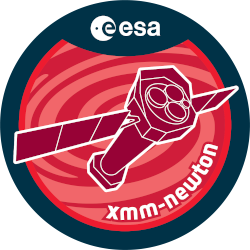

| Proposal ID | 055630 |
| Title | The extraordinary X-ray source population of NGC 4485 & 4490 |
| Download Data Associated to the proposal | https://nxsa.esac.esa.int/nxsa-sl/servlet/data-action-aio?obsno=0556300101 |
| DOI | https://doi.org/10.5270/esa-8af0szb |
| Principal Investigator, PI | Ms Jeanette Gladstone |
| Abstract | The interaction of the nearby galaxy pair, NGC 4485 & 4490 (d=7.8 Mpc), has ledto enhanced star formation in the galaxies, and hence enhanced X-ray activity.The most remarkable feature of this is a population of at least sixultraluminous X-ray sources (ULXs). Here we propose two new 40-ks XMM-Newtonobservations, with the primary aim of studying these extraordinary sources. Thedepth of the proposed observations will be sufficient to place constraints onthe presence of a cool disk in their X-ray spectra, and on the presence ofshort-term variability, whilst extending the baseline of observations tocontinue long-term spectral and temporal variability studies. We will alsodetect sufficient counts to study the extensive diffuse X-ray emission of this system. |
| Publications |
|
| Instrument | EMOS1, EMOS2, EPN, OM, RGS1, RGS2 |
| Temporal Coverage | 2008-05-19T08:29:40Z/2008-06-22T20:27:20Z |
| Version | 17.56_20190403_1200 |
| Mission Description | The European Space Agencys (ESA) X-ray Multi-Mirror Mission (XMM-Newton) was launched by an Ariane 504 on December 10th 1999. XMM-Newton is ESAs second cornerstone of the Horizon 2000 Science Programme. It carries 3 high throughput X-ray telescopes with an unprecedented effective area, and an optical monitor, the first flown on a X-ray observatory. The large collecting area and ability to make long uninterrupted exposures provide highly sensitive observations. Since Earths atmosphere blocks out all X-rays, only a telescope in space can detect and study celestial X-ray sources. The XMM-Newton mission is helping scientists to solve a number of cosmic mysteries, ranging from the enigmatic black holes to the origins of the Universe itself. Observing time on XMM-Newton is being made available to the scientific community, applying for observational periods on a competitive basis. |
| Creator Contact | https://www.cosmos.esa.int/web/xmm-newton/xmm-newton-helpdesk |
| Date Published | 2009-07-29T00:00:00Z |
| Last Update | 2025-08-04 |
| Keywords | "XMM", "xray spectra", "XMM-Newton", "term spectral", "ngc 4485", "enhanced xray activity", "NGC 4485", "nearby galaxy pair", "xmm newton", "extraordinary sources", "short term variability", "enhanced star formation", "temporal variability" |
| Publisher And Registrant | European Space Agency |
| Credit Guidelines | European Space Agency, Ms Jeanette Gladstone, 2009, 'The extraordinary X-ray source population of NGC 4485 & 4490', 17.56_20190403_1200, European Space Agency, https://doi.org/10.5270/esa-8af0szb |